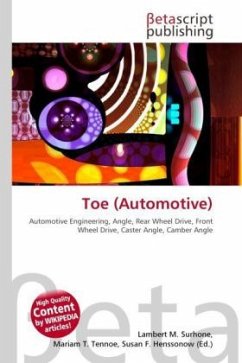High Quality Content by WIKIPEDIA articles! In automotive engineering, toe is the symmetric angle that each wheel makes with the longitudinal axis of the vehicle, as a function of static geometry, and kinematic and compliant effects. This can be contrasted with steer, which is the antisymmetric angle, i.e. both wheels point to the left or right, in parallel (roughly). Positive toe, or toe in, is the front of the wheel pointing in towards the centreline of the vehicle. Negative toe, or toe out, is the front of the wheel pointing away from the centreline of the vehicle. Toe can be measured in linear units, at the front of the tire, or as an angular deflection. In a rear wheel drive car, increased front toe in (i.e. the fronts of the front wheels are closer together than the backs of the front wheels) provides greater straight-line stability at the cost of some sluggishness of turning response, as well as a little more tire wear as they are now driving a bit sideways. On front wheeldrive cars, the situation is more complex.








